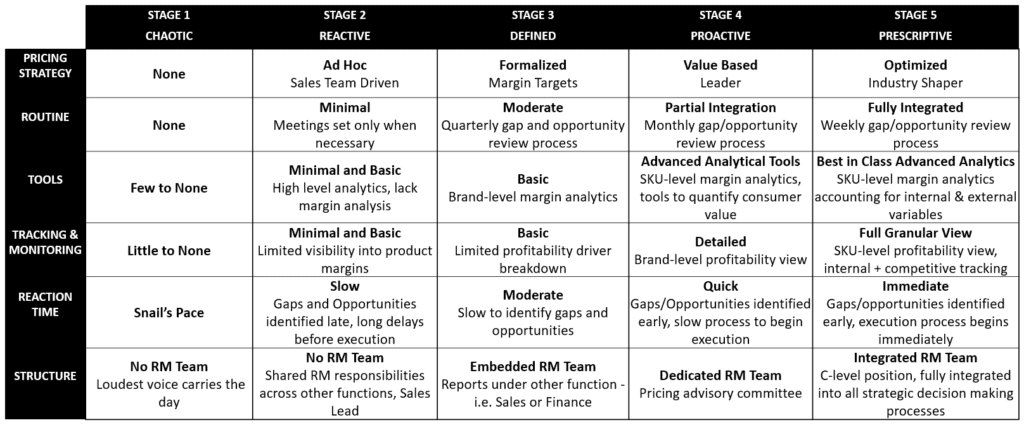Keep up to date with our latest insights! Subscribe below.
If your Revenue Management strategies are falling short of expectations, it is probably because they are outdated. Customers are constantly evolving and so should your Revenue Management capabilities. In this article, we share the four key steps of conducting an Evolution Assessment to help you improve your Revenue Management capabilities and achieve long-term profitability.
What is an Evolution Assessment?
An Evolution Assessment is a thorough assessment of an organization’s Revenue Management maturity level to gauge the scope and scale of pricing improvement opportunities available. It also helps organizations create detailed roadmaps, complete with actionable steps, to develop their internal Revenue Management capabilities. It’s a long-term revenue strategy that delivers results over time.
The Revenue Management Lifecycle
The Revenue Management Lifecycle is the progression of an organization’s Revenue Management capabilities. The five lifecycle stages are: Chaotic, Reactive, Defined, Proactive, and Prescriptive (Best-In-Class). The Evolution Assessment is used to gauge where an organization sits from a capability standpoint and understand what actions are necessary to progress along the lifecycle. Every organization has a Revenue Management lifecycle, but the time spent at each stage differs depending on how dedicated the organization is to Revenue Management improvement.
The importance of evolving your Revenue Management capabilities cannot be overstated. Depending on the organization, going from a Chaotic to Proactive Revenue Management capability can translate into profit improvements of 3x!
Revenue Management Lifecycle Stages
The Evolution Assessment Process
Now that we know what an Evolution Assessment is, it is time to explore the four key steps of the process more deeply.
1. Data Download
In this stage, a wide cross-section of data is gathered from the organization to understand how pricing decisions are made. This information is reviewed to gauge how current pricing practices compare to the Best-In-Class scenario and identify areas of opportunity for improvement.
An effective Evolution Assessment should be based on the collection of a series of data that enables strategic pricing decisions to be made. Thus, any information related to the Revenue Management pillars – Price, Volume, Mix, Execution, and Enablement – are all essential data points that need to be collected.
Some sample data points include:
Without the appropriate data, organizations would be pricing blindly – sometimes making money, but more often than not, losing money and negatively impacting financial performance.
2. Data Analysis
After all the necessary data points are collected and compiled, data analysis is conducted to identify current pricing gaps in the organization, highlight areas of opportunity for improvement, and show the organization what type of ongoing analytics are necessary. This step helps you understand what analytics are necessary to better understand the organization’s revenue challenges.
Some examples of analysis outputs include:

Sample Data Analysis Outputs
3. Revenue Management Stakeholder Interviews
In the third step of an Evolution Assessment, qualitative data is collected. Stakeholder interviews are conducted to develop a snapshot of current pricing processes and aid with key issue prioritization. By speaking with specific stakeholders responsible for Revenue Management, you get a better sense of how the organization views pricing and where they think pricing opportunities exist.
Sample Questions:
- Where are you currently in your Revenue Management journey?
- How do you currently set prices?
- How do you conduct conversations with customers?
- What does your discount structure look like?
- How do you know what price to charge different customers?
- Do you understand how customers trade-off between offers? If so, how do you validate the trade-offs?
Key Departments Surveyed:

4. Scoring & Opportunity Identification
After the quantitative and qualitative data are gathered, the information is used to benchmark the organization’s capabilities against the Best-in-Class scenario to identify opportunities for improvement. Benchmarking is done for each Revenue Management pillar (Price, Volume, Mix, Execution, and Enablement) and across 71 key processes:

Pricing: Scoring & Opportunity Identification
After all the improvement opportunities have been identified, you can then create an in-depth project plan that connects corporate goals & strategies with Revenue Management strategies. Each strategy is then ranked and prioritized in the Revenue Management Roadmap based on expected completion time and potential profit generated.
Final Thoughts
A company can achieve significant improvements in its profitability if it moves towards best-in-class Revenue Management capabilities. If you would like Revenue Management Labs to help you conduct an Evolution Assessment and ensure your Revenue Management capabilities grow as you evolve, get in touch today!
ABOUT THE AUTHOR Marc Carias is a Principal at Revenue Management Labs. Revenue Management Labs help companies develop and execute practical solutions to maximize long-term revenue and profitability. Connect with Marc at mcarias@revenueml.com






